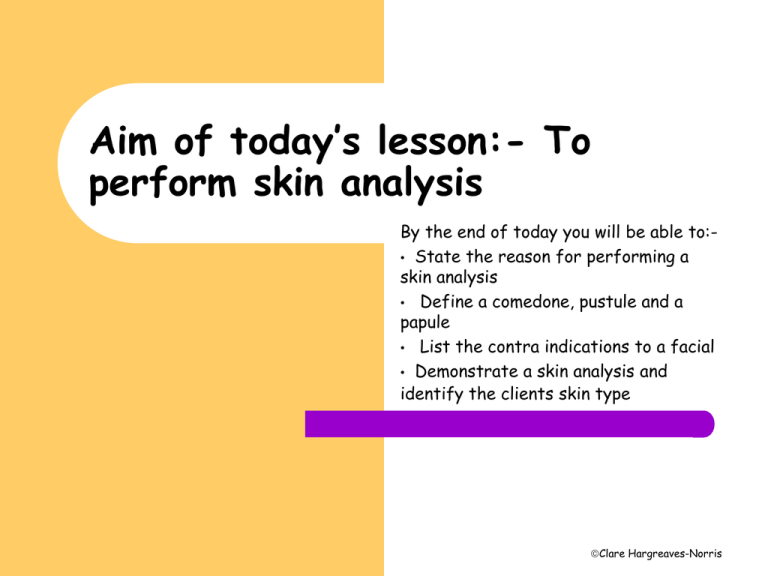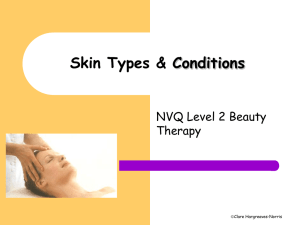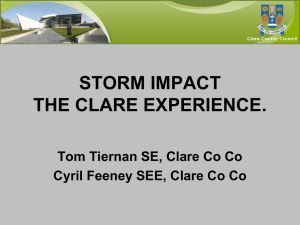BTEC-Nat-facial-skin-analysis
advertisement

Aim of today’s lesson:- To perform skin analysis By the end of today you will be able to:• State the reason for performing a skin analysis • Define a comedone, pustule and a papule • List the contra indications to a facial • Demonstrate a skin analysis and identify the clients skin type Clare Hargreaves-Norris Skin Analysis When carrying out a skin analysis you should consider the following 3 points: Look Touch Question Clare Hargreaves-Norris Look Use the magnifying light to look for characteristics and conditions to guide you in making a decision as to the client’s skin type. You would also look for areas that are showing signs of ageing. Clare Hargreaves-Norris Touch Using you fingers touch the client’s skin to feel the texture of the skin, muscle tone, elasticity, skin tone, amount of subcutaneous tissue and sebaceous secretions. Clare Hargreaves-Norris Questioning Determine their skin care routine, the type of products they are using and for what skin type and finally if they have any problems with their skin. It is important that you get the client’s point of view! Questions to ask: Have you had a facial before? How long has it been since your last facial? How was your skin after your last facial? Have you noticed any problems with your skin? Have you noticed any areas of dryness/oiliness? What is the main reason for you having a facial today? Clare Hargreaves-Norris Remember It is vital that you assess the skin correctly, otherwise incorrect products and pressure could be applied resulting in an ineffective treatment. It is also important that you find out the clients requirements from the treatment i.e. just because the client has blackheads do not automatically presume that they want them extracting. Clare Hargreaves-Norris Note The products/frequency that the client is using them can affect the current skin condition. It is important that you gain information on the client’s skin care routine and the products used. Do not presume that if the client is cleansing, toning and moisturising that the skin care routine is perfect as they may be using the wrong products or applying them incorrectly. Clare Hargreaves-Norris Skin Conditions Characteristics of the seven different skin types Clare Hargreaves-Norris The different skin conditions Seborrhoea Comedone Papules & pustules Open pores Milia Dilated capillaries Spider Naevi - Broken capillaries Ephelides (freckles) Hyper pigmentationChloasmata, Hypo pigmentation – Vitiligo, Albinism Port wine stain Strawberry marks Pseudo folliculitis Keloids Ingrowing hairs Malignant Melanomas Psoriasis, eczema, contact dermatitis Skin tags Dark circles Crows feet Wrinkles Clare Hargreaves-Norris Comedone This is the technical term for a blackhead. Comedones most commonly accompany an oily or combination skin. They are caused by an overproduction of sebum blocking the pore and when the sebum encounters oxygen the oxidising effect starts to darken the sebum, turning it into a black dot. Make-up and dirt may also block the pore making the comedone look even darker. Comedones are extracted by gently squeezing between fingers protected by tissues or by using a comedone extractor. Clare Hargreaves-Norris Papules and pustules Papules are red spots caused by inflammation of the sebaceous gland. Pustules are yellow spots also caused by inflammation of the sebaceous glands; however, infection is also present, in the form of bacteria. They commonly occur on oily and combinations skins due to the overactive sebaceous glands. However, they can occur on other skin types as hormonal imbalances (often due to the menstrual cycle or stress) can cause them to appear. Clare Hargreaves-Norris Open Pore The pores are more visible and appear enlarged. Open pores are common on oily areas of the skin. Once the pores have enlarged they can never return to normal size, so you will often see open pores on mature skins or on skins that have previously been oily or combination. Do not presume that just because the pores are open that the skin is oily, as this is a common mistake. Clare Hargreaves-Norris Milia These are often present on a dry skin and are caused by overproduction of dry skin cells causing a blockage of the sebaceous gland. They appear as a small white pearl under the skins surface, often around the eye or cheek areas. Exfoliating and applying moisturiser on a regular basis can loosen milia. Alternatively, a qualified therapist can use a sterile needle to pierce the skin and extract the milia. Clare Hargreaves-Norris Broken Capillaries Dehydrated, dry and sensitive skins often have thin skin that provides less protection and therefore, these skin types are the most commonly effected. Common causes of broken capillaries are: Hot conditions. Wind blowing on the face. Burning i.e. sunburn. Moving from one extreme temperature to another. Pressure i.e. squeezing spots or glasses pressing on the face. Broken capillaries can be prevented by avoiding all of the above. Once formed they can be treated by a specialist form of electrolysis. There are also specialist creams on the market that aim to strengthen the capillary walls thus reducing the redness. Clare Hargreaves-Norris Hyper Pigmentation This is when the skin has areas of darker coloured skin – it has increased pigment production. In general the darker the skin the more pigment is present. The colour of the skin is influenced by the amount of melanin being produced. Hyper pigmentation is common during pregnancy due to hormonal influences and also in old age when people develop liver spots (sometimes referred to as age spots). To prevent pigmentation patches occurring, advise the use of a sun block. Darker patches of skin can be disguised by the use of a concealer. Clare Hargreaves-Norris Hypo Pigmentation This is when the skin has areas of paler coloured skin – it has decreased pigment production. A common medical condition that would display paler patches of skin is vitiligo. Hypo pigmentation can be disguised with the use of a concealer. Also advise the client to use a sun block to protect against burning caused by the sun’s rays. Clare Hargreaves-Norris Pseudo Folliculitis This is inflammation of the hair follicles due to bacterial or fungal infections. The area around hair follicles looks inflamed and acne-like, and often extrudes puss. It can occur in all skin and hair types and is not always related to shaving. Clare Hargreaves-Norris Keloids A keloid is a scar that does not know when to stop growing. When the skin is injured, cells grow back to fill in the gap. In a keloid scar, the cells keep on reproducing, the result being overgrown scar tissue that looks shiny and is often dome-shaped. They can range in colour from slightly pink to red or dark brown. They feel hard and thick and are always raised above the surrounding skin. People of African or Asian descent are more likely to develop Keloids than people with lighter skin. This condition can be treated by surgery, laser, cortisone injections or freezing. Clare Hargreaves-Norris Ingrowing Hairs Ingrowing hairs are basically hairs that are trapped below the skin surface and there are 3 different types that can develop: A coiled ingrowing hair - this appears as a black dot or dome in the skin. An infected ingrowth - this would usually have a pustular raised head, contained within would be the ingrowing hair. A flat hair growing underneath the skin - this would look like a small thread and can be released with tweezers or a sterile needle by piercing the skin gently to release the hair at the root end. Ingrowing hairs can occur due to dead skin cells building up over the hair follicle. This is common after shaving or waxing an area. The client should be advised to exfoliate and moisturise regularly to prevent ingrowing hairs. Clare Hargreaves-Norris Eczema Inflammation of the skin caused by contact, internally, externally with an irritant. Redding of the skin with swelling and blisters. Blisters leak fluid which create scabs. Clare Hargreaves-Norris Psoriasis Patches of red, itchy, flaky skin covered in waxy, silvery scales. Found on the elbows, knees, lower back and scalp. Clare Hargreaves-Norris Contra indications to facials Skin disorders- Acne vulgaris, Acne Rosecea, weeping eczema, furuncles(boils) Skin diseases – Impetigo,, sebaceous cysts, Herpes Simplex (cold sore), Herpes Zoster (shingles), scabies, Ringworm Eye disorders – Conjunctivitis, sty's Bruising to area Recent Operations Scar tissue (less than 6 months old) Fracture, broken bones Inflammation or swelling to the area Allergic reaction – hives Broken skin, cuts and abrasions Clare Hargreaves-Norris Impetigo An inflammatory disease of the surface of the skin. Skin appears red and itchy, then small thin walled blisters appear. These burst and form into yellow crusts. Very contagious. Clare Hargreaves-Norris Skin analysis chart Forehead Open pores, papules, expression lines Nose Comedones, open pores, papules, broken capillaries Chin Pustules, bumpy texture Muscle Tone: Good Skin Texture: Coarse on T-zone Elasticity: Good Skin Type: Combination Eye Area Expression lines, milia ,dark circles Cheeks & Sides of Face Broken capillaries, tight pores, dry patches Neck Normal Clare Hargreaves-Norris Skin analysis chart Muscle Tone: Skin Texture: Elasticity: Skin Type: Mature Clare Hargreaves-Norris Skin analysis chart Muscle Tone: Skin Texture: Elasticity: Skin Type: combination Clare Hargreaves-Norris







